| کد مقاله | کد نشریه | سال انتشار | مقاله انگلیسی | نسخه تمام متن |
|---|---|---|---|---|
| 1409604 | 1501795 | 2012 | 7 صفحه PDF | دانلود رایگان |

The transition metal complexes of 3-methoxysalicylaldehyde-2-aminobenzhydrazone (H2L) were synthesized and characterized by various spectroscopic (IR, NMR, UV–Vis, mass), thermal and other physicochemical methods. The ligand acts both in monobasic as well as dibasic manner and coordinates in tridentate fashion with carbonyl oxygen, azomethine nitrogen and phenolic oxygen via deprotonation except in Cu(II) complex where the ligand coordinates via enolization and deprotonation of amide proton. An octahedral geometry was assigned for Mn(II), Co(II), Ni(II) and Zn(II) complexes and square planar for Cu(II) complex. The ligand and its metal complexes have been screened for their in vitro antimicrobial activities using serial dilution method. Metal complexes in general have exhibited better antibacterial and antifungal activity than the free ligand. The Cu(II) complex exhibited highest antimicrobial activity among the compounds tested.
► Transition metal complexes of 3-methoxysalicylaldehyde-2-aminobenzoylhydrazone (H2L) were prepared.
► Isolation of H2L has been achieved under reduced temperature.
► Complexes of H2L were characterized by spectroscopic and physicochemical methods.
► The ligand along with its complexes was evaluated for their antimicrobial activity.
► Among the compounds tested, Cu(II) complex has shown better activity.
Journal: Journal of Molecular Structure - Volume 1019, 18 July 2012, Pages 159–165